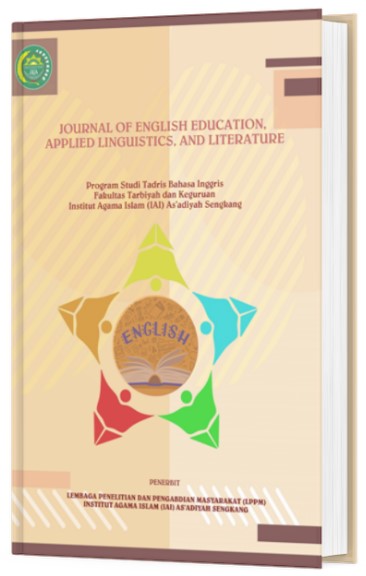CONVERSATIONAL LANGUAGE STYLE IN "THE SOCIAL NETWORK"
GAYA BAHASA PERCAKAPAN DALAM "THE SOCIAL NETWORK"
Keywords:
film linguistics, conversational analysis, power dynamics, dia-logue patterns, sociolinguistic markersAbstract
This qualitative research examines the conversational language style em-ployed in David Fincher's film "The Social Network" (2010), analyzing the linguistic patterns, power dynamics, and sociolinguistic features that char-acterize interactions between characters. The study employs discourse analysis and sociolinguistic frameworks to explore how communicative strategies reflect character development, social hierarchy, and narrative progression. Data was collected through systematic transcription and cod-ing of dialogue from key scenes, with particular attention to conversational implicature, turn-taking patterns, and linguistic markers of status. The findings reveal that "The Social Network" utilizes distinctive conversational styles to establish character personalities and relationships, with marked differences in speech patterns between status groups. These patterns include rapid-fire dialogue with intellectual one-upmanship, strategic use of interruptions, and coded language that establishes in-group/out-group dynamics. The study contributes to the field of film linguistics by demon-strating how stylized conversational elements function as characterization tools and reflect broader social dynamics. The research highlights the importance of conversational analysis in understanding cinematic storytell-ing techniques and recommends further exploration of language style in contemporary film as a reflection of changing communication norms in digital society.
Downloads
References
Androutsopoulos, J. (2012). Language and society in cinematic dis-course. Multilingua, 31(2-3), 145-167. https://doi.org/10.1515/multi-2012-0007
Berliner, T. (2017). Hollywood aesthetic: Pleasure in American cine-ma. Oxford University Press.
Bourdieu, P. (1991). Language and symbolic power. Harvard Univer-sity Press.
Brown, P., & Levinson, S. C. (1987). Politeness: Some universals in language usage. Cambridge University Press.
Bubel, C. (2008). Film audiences as overhearers. Journal of Prag-matics, 40(1), 55-71. https://doi.org/10.1016/j.pragma.2007.10.001
Chen, L. (2021). Dialogue as character: Verbal performance in con-temporary American screenwriting. Journal of Screenwriting, 12(2), 137-152. https://doi.org/10.1386/josc_00042_1
Fairclough, N. (2013). Critical discourse analysis: The critical study of language (2nd ed.). Routledge.
Goffman, E. (1981). Forms of talk. University of Pennsylvania Press.
Gumperz, J. J. (2022). Discourse strategies (2nd ed.). Cambridge University Press.
Henderson, K. (2022). Gender and speech in contemporary film: Lin-guistic patterns as characterization devices. Language and Lit-erature, 31(3), 302-318. https://doi.org/10.1177/09639470221074231
Heritage, J., & Clayman, S. (2020). Talk in action: Interactions, iden-tities, and institutions. Wiley-Blackwell.
Hoffman, C. (2020). Multilingualism in film: Code-switching as narra-tive strategy. Applied Linguistics Review, 11(2), 167-189. https://doi.org/10.1515/applirev-2019-0037
Jaworski, A. (2021). The power of silence: Social and pragmatic per-spectives (2nd ed.). Sage Publications.
Kozloff, S. (2000). Overhearing film dialogue. University of California Press.
Lakoff, R. (2019). Language and power: The politics of speech. Routledge.
Lavery, D., Leverette, M., & Ott, B. L. (2022). The art of verbal war-fare: Dialogue patterns in the works of Aaron Sorkin. Journal of Film and Video, 74(1), 3-20. https://doi.org/10.5406/jfilmvideo.74.1.0003
Martinez, R. (2023). Tech talk: Linguistic exclusion in representations of technology culture. Discourse & Society, 34(3), 283-300. https://doi.org/10.1177/09579265221147629
McHugh, K. (2018). Dialogue and power in contemporary American cinema. Film Quarterly, 71(3), 45-57. https://doi.org/10.1525/fq.2018.71.3.45
Richardson, K. (2020). Television dramatic dialogue: A sociolinguis-tic study. Oxford University Press.
Schegloff, E. A. (2007). Sequence organization in interaction: A pri-mer in conversation analysis. Cambridge University Press.
Tannen, D. (2021). Gender and discourse (3rd ed.). Oxford Universi-ty Press.
Thompson, J. (2019). Screenwriting and dialogue: Patterns of verbal expression in contemporary cinema. Journal of Film and Tele-vision Studies, 37(2), 196-212. https://doi.org/10.1080/01956051.2019.1595924
Zimmerman, D. H., & West, C. (2018). Doing gender. Gender & So-ciety, 32(1), 99-112. https://doi.org/10.1177/0891243287001002002
Downloads
Published
How to Cite
Issue
Section
License
Copyright (c) 2025 Ningrum Saraswati, Alifiyah Rahmawansyah

This work is licensed under a Creative Commons Attribution-ShareAlike 4.0 International License.







